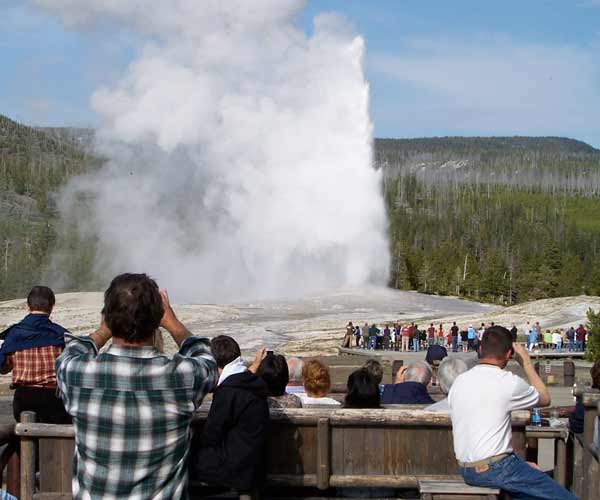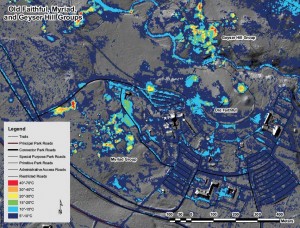
By Ruffin Prevost
Researchers and Yellowstone National Park staff members are meeting at Old Faithful this week to review the current scientific understanding of the park’s hydrothermal systems. The group will eventually develop suggestions for new research projects and design standards that could help inform and guide management of and development near Yellowstone’s thermal features.
Discussions on Monday, the first of three days when the science review panel is meeting, revealed that top experts in the field are still struggling to fully understand some details of how and why Old Faithful erupts at varying intervals averaging every 90 minutes or so, as well as other factors in how all of the park’s thermal features function.
“It’s about as complex a hydrothermal system as you could expect to find,” said Payton Gardner, a geologist with Sandia National Laboratories who is studying how the park’s thermal features are recharged by groundwater.

Gardner and others who have spent their careers studying hydrothermal systems in Yellowstone and elsewhere said it is difficult to unlock the mysteries of what’s going on underground, especially since researchers must rely on non-invasive methods that won’t disturb or alter hydrothermal processes.
It is only in the last decade that park geologists have begun using sophisticated thermal imaging technology to create detailed maps of Yellowstone’s hot spots, said Deputy Superintendent Steve Iobst.
The information will be used to guide development around Old Faithful and in other areas in an effort minimize human effects on thermal features, and to avoid repeating some of the mistakes made in past decades.
Among those past mistakes are structures built atop thermally active ground and a network of buried water, sewer and power lines that wasn’t always planned or mapped as carefully as it should have been.
“You will never figure out what’s underground in terms of infrastructure at Old Faithful,” said Nancy Ward, chief of maintenance for Yellowstone.
The area has seen a mosaic of construction for more than 100 years, Ward said, and more than 30 miles of buried utilities snake underneath the buildings and roads. That includes a complex jumble of abandoned water and sewer lines that park officials don’t know whether to dig up or leave in place.
Maintenance crews have often re-routed underground infrastructure as buildings are torn down, removed or refurbished, or when pipes fail from age or thermal stress.
Visitation to Yellowstone continues to trend upward, and Old Faithful remains by far the most popular spot in the park. Accommodating those growing crowds without disturbing geysers, hot springs and mudpots is one of the best examples of the difficulty in balancing the National Park Service’s mission of protecting resources while allowing for appropriate public use, Superintendent Dan Wenk said.
As the Park Service considers new ways to better handle an average of 20,000 daily summer visitors at Old Faithful, planners will be relying on guidance from the panel of scientific advisors gathered at this week’s conference, which is funded by the Yellowstone Park Foundation.
Panelists will help identify potential future problems and may suggest options for design standards that can be applied around any of the hundreds of thermal features spread throughout Yellowstone.
Significantly restricting access to the park’s most popular attraction is not a politically viable option. So park managers are exploring ideas for how to better manage the throngs by making small changes that will cost relatively little, said Eleanor Clark, chief of comprehensive planning for Yellowstone.
Ranger Colleen Rawlings compared the Old Faithful crowd control challenge to Times Square in New York.
“Imagine Times Square at midnight on New Year’s Eve, and then Times Square on any other day of the year.” Rawlings said. “You see that same difference at Old Faithful, only it fluctuates every 92 minutes.”
Contact Ruffin Prevost at 307-213-9818 or [email protected].

To truly save Yellowstone all roads and man made structures should be removed. Then the visitors will only be backpackers and horse riders.